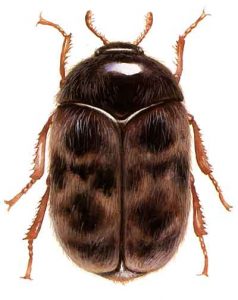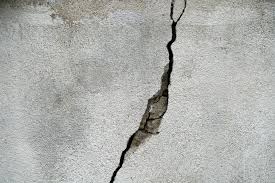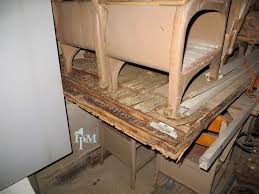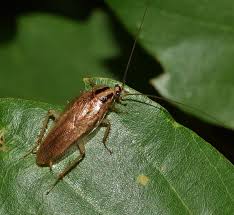 About 5k million chickens are being raised every year as a source of food, both meat and eggs of chicken. The commercial egg laying industry is comprised of over 273 million laying hens, of which about 237 million produce table eggs, the eggs one buys at the supermarket and the rest for fertile hatching eggs as a replacement for the laying flocks.
About 5k million chickens are being raised every year as a source of food, both meat and eggs of chicken. The commercial egg laying industry is comprised of over 273 million laying hens, of which about 237 million produce table eggs, the eggs one buys at the supermarket and the rest for fertile hatching eggs as a replacement for the laying flocks.
But the huge poultry industry has to face the nuisance caused certain insects!
Litter beetles are common pests in poultry houses and are well known for eating feed, disturbing chickens, harboring diseases and causing damage to the poultry housing. If the infestation in the house is heavy enough, beetles are even known to kill weakened chickens in their search for moisture and food. In addition to directly affecting the birds, beetles can cause significant damage to poultry houses – it is common for them to do damage to wood and insulation while searching for food and place to pupate. Litter beetles are nocturnal insects, have no natural enemies in the environment, and because of their long association with birds are attracted to ammonia.
In the past few years, litter beetles have become the most serious pest affecting several types of poultry production systems. Entomologists who work with arthropod pests of poultry give priority to litter beetles because they have a high reproductive rate, are difficult to control, are vectors of disease, cause considerable damage to insulation in poultry facilities, and may migrate from litter disposal sites to urban housing areas where they are a nuisance. They also may consume considerable amounts of poultry feed if they are very numerous.
Because the beetles feed on poultry carcasses and because poultry may feed on them, litter beetles are mechanical vectors of several diseases, including Marck’s disease, avian influenza, salmonella, fowl pox, coccidiosis, botulism and New Castle disease. They also are reservoirs of and vectors of cecal worms and tapeworms.
Adult litter beetles are black or dark reddish-brown and about 1/4 inch long. Larvae are yellowish-brown and
Poultry lice are small, less than 1/8 inch, wingless insects with chewing mouthparts.
The most common are brown chicken lice and chicken body lice. Less important are large chicken lice, shaft lice, chicken head lice, fluff lice, and several other species which are rarely present.
Egg production is reduced, and heavily infested birds refuse to eat and gradually lose weight. Lice can be observed moving on the skin when feathers are parted, especially around the vent, head, and underwings.
Several kinds of mites attack poultry. The most common are chicken mites and northern fowl mites. Occasionally scaly-leg mites are a problem. Mites vary in size 1/16 to 1/8 inch long and structure, have eight legs, and have mouthparts on the anterior of the body. Usually, there are no clearly defined body divisions.
 Chicken mites feed at night. During the day they remain in cracks around roosts and interior portions of poultry houses. At night, they feed on the birds as they roost or nest. Chicken mites are small and grey or yellow in color but darken after filling with blood. Northern fowl mites remain on poultry. They are small and red or brown. Feathers of infested birds are discolored by mite excrement and eggs, and the skin is scabby. Scaly-leg mites burrow under the skin, especially on the lower legs and feet. Legs become scaly, swollen, and exude lymph fluid. Severely infested birds may be crippled or unable to walk.
Chicken mites feed at night. During the day they remain in cracks around roosts and interior portions of poultry houses. At night, they feed on the birds as they roost or nest. Chicken mites are small and grey or yellow in color but darken after filling with blood. Northern fowl mites remain on poultry. They are small and red or brown. Feathers of infested birds are discolored by mite excrement and eggs, and the skin is scabby. Scaly-leg mites burrow under the skin, especially on the lower legs and feet. Legs become scaly, swollen, and exude lymph fluid. Severely infested birds may be crippled or unable to walk.
The common bedbug and several other closely related insects feed on poultry. They are flat, wingless, bloodsucking insects that are about 1/5 inch long when fully grown. They have a very distinctive pungent odor when crushed. Bedbugs feed at night, hiding and laying eggs behind insulation, in wall cracks, loose boards, nests and other dark areas during the day. At night they move to sleep birds and suck their blood. Small, dark fecal spots around cracks, roosts, and on chicken eggs frequently are observed. Bedbugs can be carried into poultry houses by other birds or into human dwellings where they become a pest of humans.
 Other blood-feeding insects or mites that may occasionally be pests of poultry include chigger mites, biting midges, and black flies (turkey gnats). Chiggers may be a problem where turkeys are kept on an open range. Chiggers often are covered with dense, feathered hairs that give them a velvety appearance. They are often bright red with a figure-eight-shaped body about 1 mm long.
Other blood-feeding insects or mites that may occasionally be pests of poultry include chigger mites, biting midges, and black flies (turkey gnats). Chiggers may be a problem where turkeys are kept on an open range. Chiggers often are covered with dense, feathered hairs that give them a velvety appearance. They are often bright red with a figure-eight-shaped body about 1 mm long.
Feeding by the chigger (larvae) creates scabby, reddish lesions that require two to three weeks to heal after the engorged mites leave the bird.
House flies are the most persistent and common fly pest, although other species such as blowflies and little house flies also are present. House flies do not bite poultry, but are severe nuisances, and can spread some poultry diseases. House flies are present because of poultry manure and exposed wet feed, which is ideal feeding and breeding materials.
Rodents, insects, poor sanitation found at Rose Acre egg facility
BY DAN FLYNN | MAY 8, 2018
FDA’s Form 483, observations for the March 26 to April 11, 2018 inspection of Hyde County Egg at 1560 Hyde Park Canal Road in Pantego, NC, documents problems at the production facility for three million hens producing 2.3 million eggs per day.
pests were a problem dating back to at least September 2017, according to records examined by FDA inspectors.
A steel wool scrubber was removed by an employee from a dustpan of water and egg mix and used to scrub debris off the egg buffers.
Finally, numerous flying insects were inside the egg processing facility.
Rose Acre’s recall is the largest since 2010 when 550 million eggs were called back from two Iowa egg production facilities owned by one-time egg baron Austin “Jack” Decoster.
“Jack” and Peter DeCoster and Quality Egg LLC paid a total of $7 million in fines, and the father and son each served three months jail for allowing their bad eggs to reach the market. Almost 2,000 people were sickened by the recalled DeCoster eggs.
The invited pests must be stopped from entering the poultry. To achieve same the poultry owners spray dangerous insecticides and pesticides in the farms which is dangerous for the animals from the poultry farms. Also, even after fumigating the pests continue to enter the poultry premises.
C Tech Corporation can offer an eco-friendly solution to the nuisance caused by the insects in the poultry farms. Our product TermirepelTM is low-toxic, non-hazardous and insect aversive. Our products work on the mechanism of repellence and they do not harm or kill the target species but generate fear or trigger temporary discomfort within the pests that keep the pests away from the application.
Our product works on the mechanism of repellency. It temporarily inhibits the mating cycle of the insects. The product impairs the ability of the insects to reproduce, that is the insects will not lay eggs or the laid eggs will be infertile. The product causes feeding disruption in an insect by triggering an unpleasant reaction within the insect which might try to feed on the application. The product temporarily blocks the reproduction system of the insects by hindering the release of the vital hormones for growth.
Our product is compliant with RoHS, RoHS2, ISO, APVMA, NEA, EU-BPR and REACH and is FIFRA exempted. The green technology-based product can protect the crops and prevent the loss caused by the corn rootworm and other insects as well.
Our TermirepelTM masterbatch can be incorporated with various polymeric applications like feeder, drinkers, incubators, foggers, plates etc. used in the poultry farms.
TermirepelTM is available in liquid concentrate which can be mixed in paints and be applied on the interior and exterior of the poultry farms.
TermirepelTM is available in lacquer form. These products can be directly sprayed or applied to the application as a topical application. It can be applied to the already laid pipes and tubing in the poultry farm. It can be applied to the already installed applications used in poultry farms. The lacquer is compatible with most of the surfaces like wood, metal, concrete, polymers, ceramics, etc.
Thus, using our products, you can get an effective solution to fight menace caused by insects!
Contact us at technical.marketing@ctechcorporation.com to keep the pests away.
Also, visit our websites:
http://www.ctechcorporation.com/
http://www.rodrepel.com/
http://www.termirepel.com/
http://www.combirepel.com/
Follow our Facebook pages at:
1] https://www.facebook.com/Combirepel-411710912249274/
2] https://www.facebook.com/Termirepel-104225413091251/
3] https://www.facebook.com/Rodrepel-120734974768048/
Follow us on our Twitter pages at:
1] https://twitter.com/rodrepel
2] https://twitter.com/termirepel
3] https://twitter.com/combirepel


















